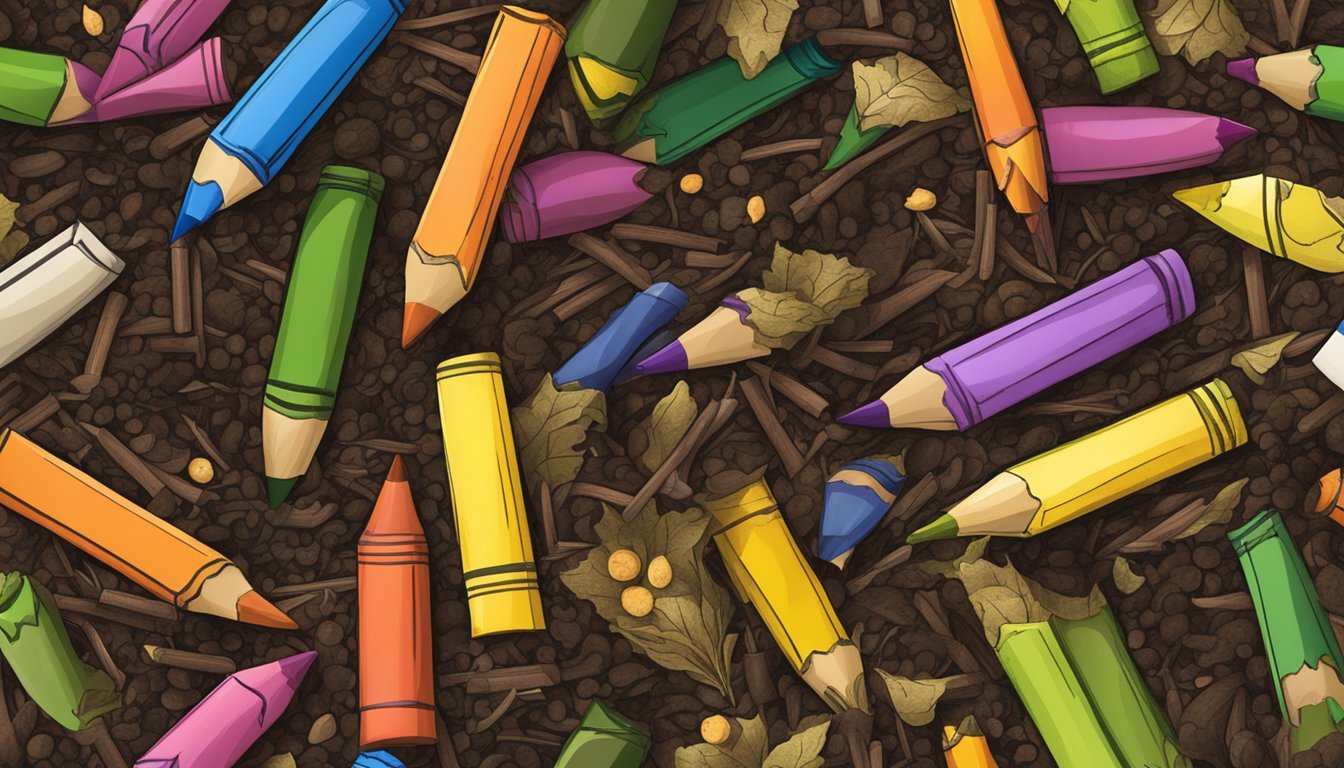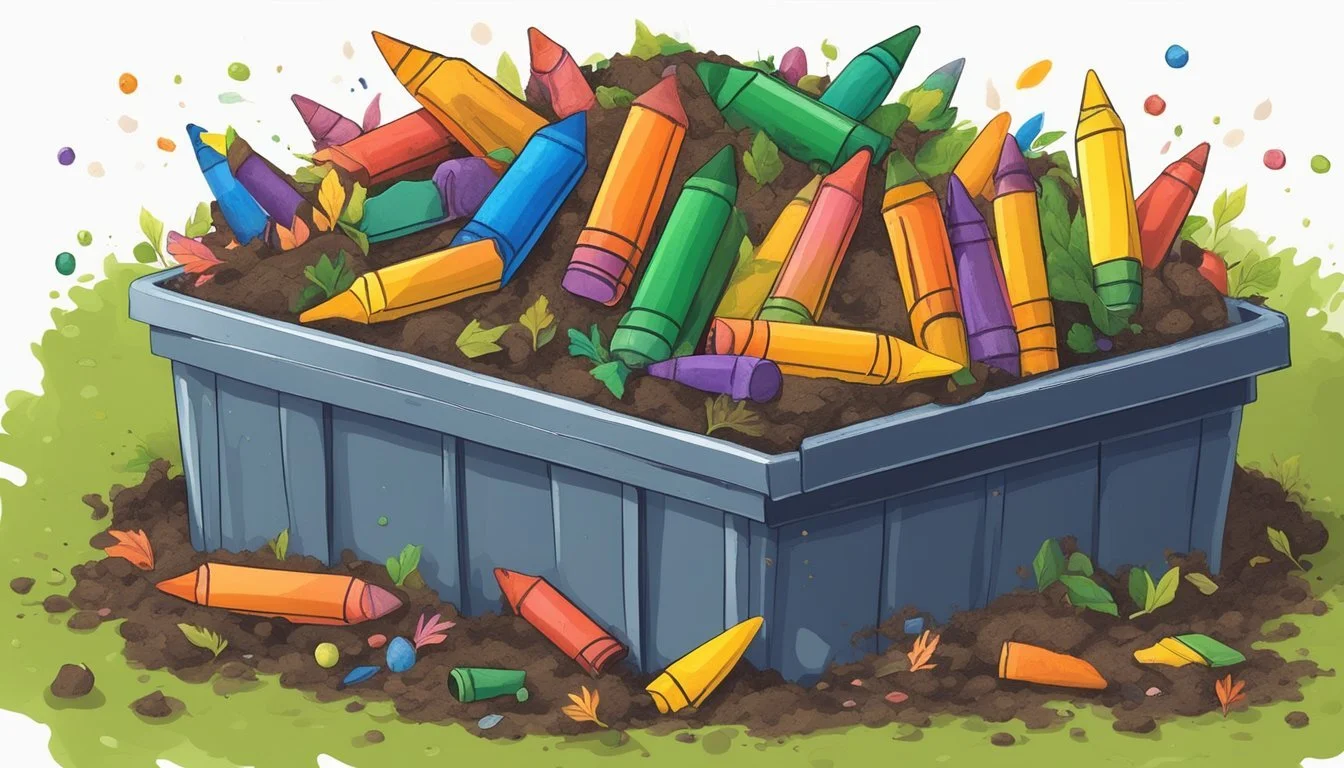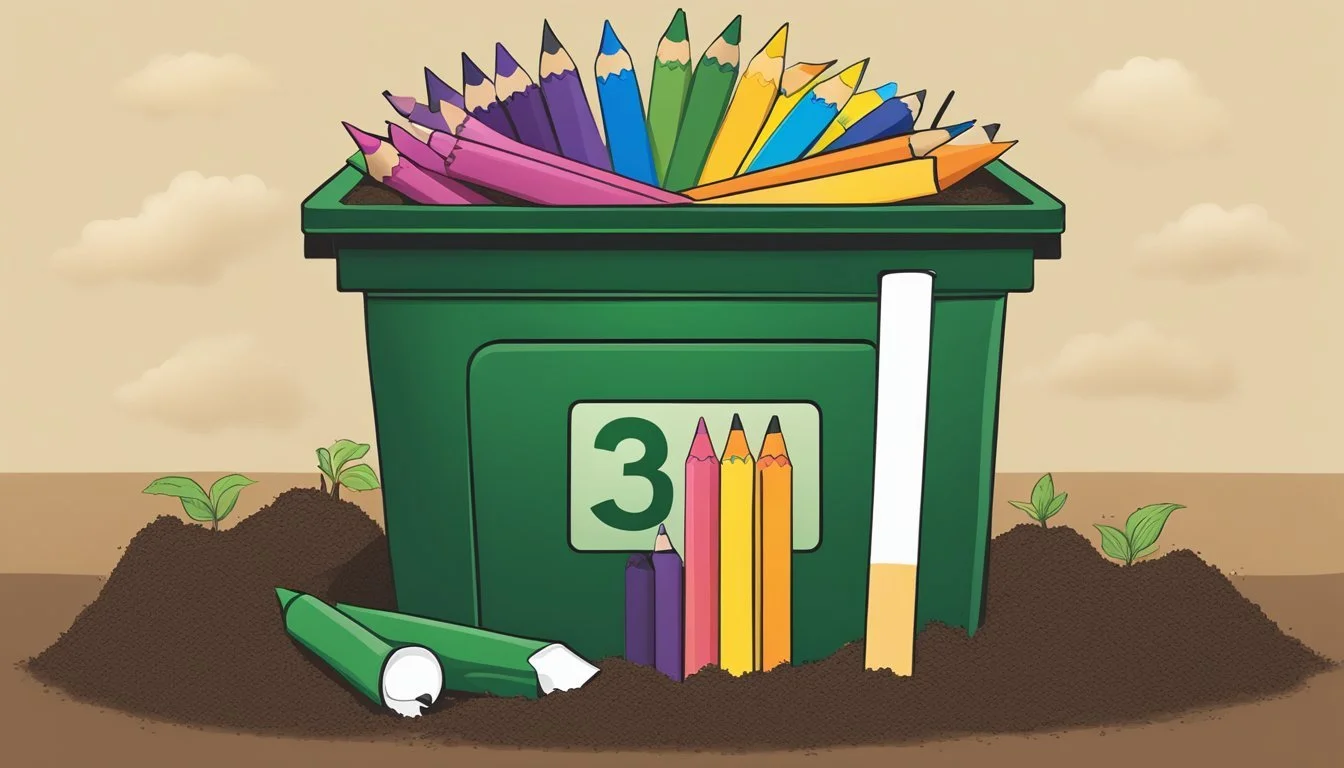Can You Compost Crayons?
Understanding Their Biodegradability
Composting has become a widespread practice for managing organic waste, turning food scraps, yard clippings, and certain paper products into nutrient-rich soil amendments. The list of items suitable for composting extends beyond the common kitchen and garden waste; however, not all materials break down effectively in a compost pile. Some items may introduce toxins or create imbalances in the delicate microbial ecosystem crucial for efficient decomposition.
Crayons, ubiquitous in households and schools, often end up as waste due to their waxy composition and eventual diminutive size. While traditional composting wisdom might suggest that crayons, being a byproduct of non-renewable petroleum, are not suitable for composting, advances in recycling and waste management have provided avenues for reusing and repurposing these colorful sticks. Before deciding to compost crayons, it is vital to understand their material composition and the potential impact on compost quality.
Understanding Composting
Composting is the process of recycling organic matter into a valuable soil amendment through controlled biological decomposition. It involves managing natural decay to benefit one's garden and reduce organic waste in landfills.
Composting Basics
Composting requires four main components: greens (nitrogen-rich materials), browns (carbon-rich materials), water, and air. An ideal compost pile maintains a balance of these elements to support the activity of microorganisms that break down organic matter.
Greens: Vegetable scraps, fruit waste, coffee grounds
Browns: Dry leaves, sticks, shredded paper
A balance often recommended is one-part greens to two-parts browns.
The Science of Decomposition
Decomposition in a compost pile is primarily an aerobic process, requiring oxygen to function effectively. Microbes, which include bacteria and fungi, are the powerhouses of composting. They generate heat as they decompose organic matter, and this temperature rise is a sign of successful breakdown. Vital to the process is the correct ratio of nitrogen to carbon, which fuels microbial growth and speeds up decomposition. Too much nitrogen can lead to odor, while too much carbon can slow down the process.
Optimal ratio: About 25-30 parts carbon to 1 part nitrogen
Temperature: Should reach between 140°F - 160°F for effective decomposition
Benefits of Composting
Composting transforms kitchen and yard waste into a nutrient-dense soil amendment that benefits plants by improving soil structure, fertility, and water retention. It is environmentally beneficial; by diverting waste from landfills, composting helps reduce methane emissions, a potent greenhouse gas produced when organic waste decomposes anaerobically—without oxygen—in landfills.
Provides essential nutrients for plant growth
Enhances soil structure and prevents soil erosion
Moreover, composting educates individuals about the cycle of nature and their part in waste reduction.
Materials Appropriate for Composting
When composting, it's essential to balance "green" nitrogen-rich materials with "brown" carbon-rich items, while avoiding certain products that could disrupt the composting process.
Green Materials
Green materials provide necessary nitrogen for the compost. They include:
Fruit and vegetable scraps: This includes peels, stems, leaves, and any other parts not consumed.
Coffee grounds and tea bags: After brewing, these waste materials contribute nitrogen.
Grass clippings: Freshly cut grass adds a rich source of nitrogen when mixed in moderation.
Food scraps: Leftovers that are not meat, dairy, or oil can be composted.
It's important to cut larger items into smaller pieces to speed up the composting process.
Brown Materials
Brown materials supply carbon, which is as vital as nitrogen in composting:
Leaves: Dry leaves are an excellent source of carbon, breaking down over time.
Cardboard and shredded paper: These should be free of inks and other contaminants.
Newspaper: The paper should be non-glossy and shredded to improve breakdown.
Straw and hay: They should be free from seed heads to avoid growing unwanted plants in the compost.
Wood chips and sawdust: These must be from untreated wood to avoid chemicals.
Egg cartons: Cardboard egg cartons can be shredded and added to the compost.
These items should be balanced with green materials to maintain a healthy compost.
Items to Avoid
Certain items can be harmful to the composting process and should not be included:
Meat or dairy products: These can attract pests and cause odors.
Diseased plants: To avoid spreading diseases within the compost.
Colored or glossy paper: The inks can be toxic and hinder the composting process.
Plastics and metals: These do not break down in compost and can be toxic.
By avoiding these, the compost is kept healthy and effective for garden use.
Crayons in Composting
When considering crayons for composting, one must take into account the crayon's composition and its potential effects on the composting process. There are both biodegradable and non-organic crayon options, impacting the decision of whether they can be included in a compost pile.
Can You Compost Crayons?
It's possible to compost crayons made from natural materials such as beeswax or soy wax, as these ingredients are biodegradable. However, most conventional crayons contain paraffin wax, derived from petroleum, and are not suitable for composting because they do not break down easily and can release contaminants.
Biodegradable Crayon Materials:
Soy wax
Non-Compostable Crayon Materials:
Paraffin wax (petroleum-based)
The Impact of Crayons on the Compost Process
Crayons composed of natural waxes contribute to the carbon content of a compost pile, which is necessary for maintaining a balanced carbon-to-nitrogen ratio. Conversely, crayons with petroleum-based waxes can interfere with the composting process due to their non-biodegradability, potentially leading to a slower decomposition rate and contamination of the compost with non-organic materials.
Alternatives to Composting Crayons
Recycling is a viable alternative for crayons that are not suitable for composting. Programs such as "Crazy Crayons" collect and repurpose used crayons into new ones. This practice provides an environmentally friendly option, diverting non-biodegradable crayons from landfills and minimizing waste.
Recycling Options for Non-Biodegradable Crayons:
Crazy Crayons recycling program
Local crayon recycling initiatives
Starting and Maintaining a Compost Pile
To effectively start and maintain a compost pile, one must prioritize proper setup, balance of composting materials, and regular maintenance. These pivotal steps foster a conducive environment for breaking down organic matter into nutrient-rich finished compost.
Setting Up a Composting Bin
A compost bin should be strategically positioned in an area with good drainage and a balance of sunlight and shade. They may opt for a stationary bin or a tumbling bin for ease of turning. Essential features to consider include adequate ventilation and accessibility for adding materials and removing finished compost.
Recommended Compost Bin Setup:
Location: Level, well-drained ground
Sunlight: Partial sun to accelerate decomposition without overheating
Ventilation: Sufficient holes or slats to allow air flow
Size: Adequate to contain the desired volume of compost, typically at least 3 feet in width and height
Proper Balance of Materials
An effective compost pile requires a balanced mix of nitrogen-rich materials ("greens") and carbon-rich materials ("browns"). Greens include items such as vegetable scraps and grass clippings, while browns encompass leaves, straw, and paper. A general guideline is to aim for a ratio of 30:1 carbon to nitrogen content for optimal decomposition.
Material Balance Tips:
Greens: Supply nitrogen - fruit and vegetable scraps, coffee grounds, fresh grass clippings
Browns: Supply carbon - dry leaves, straw, wood chips, cardboard
Avoid adding grease, oils, or meats as they can attract pests and disrupt the composting process.
Turning the Pile
Regular turning aerates the pile, distributing moisture and temperature, which are crucial for decomposing organisms. They should turn the compost pile every few weeks using a pitchfork or a compost aerator tool. Turning is particularly important when the pile's temperature plateaus or when adding fresh materials.
Turning Frequency:
Early Stages: Every 3-4 days to kickstart the process
Established Pile: Every 1-2 weeks or when temperatures start to fall
In summary, they can produce high-quality compost by ensuring a proper setup of the compost bin, maintaining a balanced mix of materials, and frequently turning the pile to assist the decomposition process.
Troubleshooting Common Composting Problems
Maintaining the right balance of moisture, temperature, and aeration is crucial for a healthy compost pile. Imbalances can lead to odors, pests, and slow decomposition, impacting the efficacy of composting efforts.
Odors and Pests
Odors emanate from compost piles when there is an excess of nitrogen-rich materials, leading to a low carbon-to-nitrogen ratio. To rectify this, one should add more carbon-rich materials such as leaves, straw, or paper to the pile. Composting odors also attract pests such as flies and rodents, which can be mitigated by covering fresh waste with a layer of soil or finished compost and by maintaining a well-mixed pile to discourage pest inhabitation.
Slow Decomposition
Slow decomposition occurs when compost piles lack adequate temperature or aeration. Piles should maintain a temperature between 120°F and 160°F (49°C - 71°C). If the pile is too cold, it suggests a need for more nitrogen-rich materials like food scraps or grass clippings to increase the temperature. Furthermore, regular turning enhances oxygen flow, speeding up the decomposition process.
Excessive Moisture
A compost pile that is too wet can become smelly and soggy, which can lead to the growth of undesirable pathogens. For optimal moisture, the pile should have the wetness of a wrung-out sponge. If the compost is excessively moist, adding dry, carbon-rich materials and turning the pile to introduce air are effective methods of restoring balance. Additionally, protecting the pile from rain with a cover can prevent excess water while ensuring it doesn’t become too dry.
Composting Regulations and Best Practices
When embarking on composting, it's crucial to be informed about local laws and participate in community programs while accessing educational resources to ensure compliance and effectiveness.
Understanding Local Composting Laws
Local composting regulations dictate how individuals and entities can manage and process organic materials. These rules can involve permit requirements, the categorization of compostable materials, and standards for operations. For example, some states require composting facilities to notify state environmental departments of their activities, as they are related to solid waste management.
Community Composting Programs
Community composting programs benefit from being less resource-intensive and often require less land and materials. They operate under the premise of using best management practices which encompass odor control, pest management, and maintaining the carbon-to-nitrogen ratio (commonly 30:1) to create high-quality compost. These programs serve as a localized solution that adheres to state and municipal regulations while fostering a sense of shared responsibility.
Educational Resources
Education plays a pivotal role in successful composting. Authorities and organizations often offer guides and workshops on the science of composting, which cover important considerations such as material balance, monitoring, and recordkeeping. These resources are vital for individuals and communities to understand the regulations and the practical aspects of implementing and maintaining an effective composting program.
Environmental Impact and Sustainability
Crayons, if not disposed of responsibly, can end up in landfills, contributing to environmental pollution. Addressing crayon waste through composting may seem like a solution, but there are complexities to consider due to their paraffin wax content.
Reducing Waste with Composting
Composting serves as a key method in reducing waste by allowing organic matter to decompose naturally, returning valuable nutrients back into the soil. It is a sustainable practice that decreases the volume of waste sent to landfills. However, crayons made of paraffin wax do not break down efficiently in compost systems due to their non-biodegradable nature.
Compost Use in Sustainable Farming
Sustainable farming integrates compost use to improve soil fertility and structure, enhancing the growth of crops without relying on chemical fertilizers. The incorporation of compost enriches the soil with organic matter, supporting water retention and fostering a diverse microbial ecosystem. Crayons, typically excluded from compost for agriculture, would not contribute to this process as they do not provide the same benefits as compostable organic materials.
Lifecycle of Composted Materials
The lifecycle of composted materials involves a transition from raw organic waste into a nutrient-rich soil amendment. Throughout this process, materials break down and are transformed into humus, which provides a slow release of nutrients essential for plant growth. Non-organic items, like crayons, interfere with this lifecycle and pose challenges in waste management within a composting framework. It's essential to sift them out to maintain the efficacy and quality of the resulting compost.
Advanced Composting Techniques
Advanced composting techniques can enrich soil with nutrients and promote sustainable waste management. They focus on specific methodologies to accelerate decomposition and handle a variety of organic materials.
Vermicomposting
Vermicomposting utilizes the natural process where certain species of worms, such as Eisenia fetida or red wigglers, break down organic matter. This method is efficient for small-scale operations, including households and classrooms. The byproduct, vermicast, is a highly nutrient-rich material excellent for enhancing soil health.
Key points:
Ideal for small and indoor spaces.
Requires worms specifically suited for composting.
Bokashi Composting
Bokashi Composting is an anaerobic process involving the layering of organic waste with a bran-based inoculant. This mixture is then sealed in an airtight container, where a fermentation process ensues, breaking down even meat and dairy products which are typically problematic for traditional composting. After fermentation, the material can either be buried or added to a compost pile to complete decomposition.
Key points:
Aims to compost a broader range of organic materials, including cooked food.
Requires an inoculant like Bokashi bran to initiate fermentation.
Large-Scale Composting Operations
Large-Scale Composting Operations cater to communities, municipalities, or agricultural activities. These setups have the capacity to handle significant volumes of waste and are often designed to regulate parameters like temperature, aeration, and moisture to optimize the composting process.
Key points:
Designed to process large amounts of organic waste efficiently.
May involve mechanized systems for aeration and temperature control.
Conclusion
While crayons can technically be included in compost, their composition warrants a closer examination for sustainable practices. Crayons are primarily made of paraffin wax, which is derived from petroleum, a non-renewable resource. Therefore, they do not align well with the principles of sustainability, given that they do not biodegrade as readily as organic materials.
Individuals seeking to maintain a more environmentally responsible approach to composting should consider the following:
Material composition: Crayons' paraffin content is slow to decompose and can introduce contaminants.
Colorants: The pigments used for coloring may contain heavy metals or other substances not suitable for compost that benefits plant growth.
For a healthier compost and a more sustainable practice, it is preferable to exclude crayons from the compost pile. Instead, reuse or recycle them if possible, or look for crayon recycling programs that repurpose old crayons into new ones. By making informed decisions and spreading awareness about the composting process, individuals contribute to a broader positive impact on environmental health.










